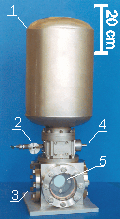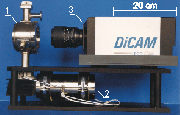
Technical realisation of the IR converter
The IR converter consists of a cell module and a cryostat, which includes the cell module. At present there exsiting different realisations as well for the cell module as for the cryostat. Each part is optimised for different applications.
Cell module
The cell module is an apparatus, which includes semiconductor, spacer and the transparent anode. At present there are available an open and a closed module The opened version comes into operation in laboratory because very part of the module can be exchanged easily. The closed cell module features a compact size. After assembling this module no parts can be exchanged. The advantage of the closed module is that it operates with a compact Stirling cooler. The following images shows such a closed cell module.

Image of
a closed cell module:
(1) electrical contact for the high voltage
supply
(2) filling tube
(3) view on the input window of the cell module
Cryostat and cooling
The cell module is cooled down to approximately 80 to 100 K with the help of the cryostat. The cooling power has to be in the order of 2 W (for the closed cell module). The open cell module is cooled with liquid nitrogen. The dewar (1) has a volume of 6 litres which supports a continuous operation of approximately 8 hours. The cell module (5) is placed in the cube (3) (compare following image of the system). The connections for electrical supply (4), vacuum system (2) and other compontens is placed between the dewar and the cube.

Picture of the
lab version with liquid nitrogen cooling.
The closed cell module can be cooled either with liquid nitrogen or with a Stirling cooler. The last pictures shows a system in which a closed cell (1) is cooled with a compact Stirling machine (2).

Image of the
closed cell (1) cooled compact Stirling machine (2) in combination with
an intensified CCD camera (3).